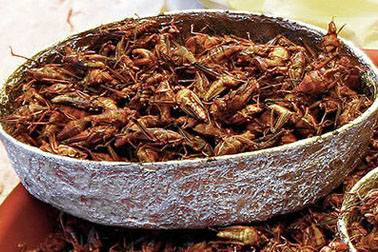 What will the future of eating look like? I’ve heard a lot of different responses to this question. The daily, high-meat diet, best exemplified by American eating habits, surely isn’t sustainable in the long term. The artificially cheap meat US consumers have come to depend on is only made possible with heavy government subsidies and great environmental cost. Long before China and other up-and-comers reach a Wes tern standard of living, resource exhaustion will put an end to factory farms. (Hopefully before one of these cesspools unleashes the long-dreaded “super bug”.) A strong case can be made for vegetarianism as the new standard. A basic rule of ecology is that energy is lost with every link in the food chain. Over the course of its life, a rabbit consumes a great number of vegetable calories. When the fox catches up, however, only a small portion of that captured energy goes into his stomach. Ninety percent of the food energy a rabbit takes in over its lifetime is used up, with running, digging, procreating, etc. Only what’s left goes towards building rabbit muscles and other tissue, which can make a later meal for a predator. For omnivores like us, therefore, strained resources can be made to stretch further if we eat the rabbit food instead of the rabbit. Or, to be more accurate, if we ate the grain we were growing, instead of force-feeding steers with it (who are naturally grass-eaters) and eating them for a fraction of the calories. So long as we can get all the nutrients we need, particularly protein, most arable farmland can be made better use of by growing food for people instead of animals for people. Proof of concept of a balanced, meatless diet can be found in any number of largely vegetarian countries, India being the most prominent example. Of course, this is more easily accomplished in some environments than others. Not all land or climates are made equal. In “The Omnivore’s Dilemma,” Michael Pollan suggests that those of us who wish to continue consuming meat can do so, but we need to produce it differently, and perhaps in smaller quantities. As his paragon of sustainability, he holds up Joel Salatin. Salatin is the owner of Polyface, a multi-use farm that mimics natural ecosystems. He doesn’t use artificial fertilizers, increase animal density above healthy or humane levels, or exhaust the land by overworking it.
What will the future of eating look like? I’ve heard a lot of different responses to this question. The daily, high-meat diet, best exemplified by American eating habits, surely isn’t sustainable in the long term. The artificially cheap meat US consumers have come to depend on is only made possible with heavy government subsidies and great environmental cost. Long before China and other up-and-comers reach a Wes tern standard of living, resource exhaustion will put an end to factory farms. (Hopefully before one of these cesspools unleashes the long-dreaded “super bug”.) A strong case can be made for vegetarianism as the new standard. A basic rule of ecology is that energy is lost with every link in the food chain. Over the course of its life, a rabbit consumes a great number of vegetable calories. When the fox catches up, however, only a small portion of that captured energy goes into his stomach. Ninety percent of the food energy a rabbit takes in over its lifetime is used up, with running, digging, procreating, etc. Only what’s left goes towards building rabbit muscles and other tissue, which can make a later meal for a predator. For omnivores like us, therefore, strained resources can be made to stretch further if we eat the rabbit food instead of the rabbit. Or, to be more accurate, if we ate the grain we were growing, instead of force-feeding steers with it (who are naturally grass-eaters) and eating them for a fraction of the calories. So long as we can get all the nutrients we need, particularly protein, most arable farmland can be made better use of by growing food for people instead of animals for people. Proof of concept of a balanced, meatless diet can be found in any number of largely vegetarian countries, India being the most prominent example. Of course, this is more easily accomplished in some environments than others. Not all land or climates are made equal. In “The Omnivore’s Dilemma,” Michael Pollan suggests that those of us who wish to continue consuming meat can do so, but we need to produce it differently, and perhaps in smaller quantities. As his paragon of sustainability, he holds up Joel Salatin. Salatin is the owner of Polyface, a multi-use farm that mimics natural ecosystems. He doesn’t use artificial fertilizers, increase animal density above healthy or humane levels, or exhaust the land by overworking it.
How the Future of Eating Looks Like?

